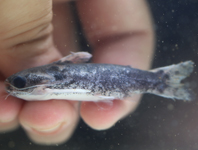Abstract
Intact voucher specimens are essential to allow detailed morphological observations on specimens that are used in molecular genetic studies. This can be achieved either by dissection of small, taxonomically uninformative parts of the body for DNA extraction or by employing non-destructive DNA extraction methods. The latter is particularly important for small-bodied animals. Here we test the effects of Chelex-based DNA extraction on the integrity of setae and setules in Amphipoda, fragile structures of great taxonomic importance. Our results show that DNA extraction using Chelex had no influence on the setae and setule structure and is well suited for reverse taxonomic approaches and the long-term storage of morphological vouchers. A detailed protocol for non-destructive DNA extraction is provided.
References
Böhm, A., Bartel, D., Szucsich, N.U. & Pass, G. (2011) Confocal imaging of the exo- and endoskeleton of Protura after nondestructive DNA extraction. Soil Organisms, 83 (3), 335–345.
Brix, S., Bober, S., Tschesche, C., Kihara, T.C., Driskell, A. & Jennings, R.M. (2018) Molecular species delimitation and its implications for species descriptions using desmosomatid and nannoniscid isopods from the VEMA fracture zone as example taxa. Deep Sea Research Part II: Topical Studies in Oceanography, 148, 180–207.
https://doi.org/10.1016/j.dsr2.2018.02.004
Cornils, A. (2015) Non-destructive DNA extraction for small pelagic copepods to perform integrative taxonomy. Journal of Plankton Research, 37 (1), 6–10.
https://doi.org/10.1093/plankt/fbu105
Kamanli, S.A., Kihara, T.C., Ball, A.D., Morritt, D. & Clark, P.F. (2017) A 3D imaging and visualization workflow, using confocal microscopy and advanced image processing for brachyuran crab larvae. Journal of Microscopy, 266 (3), 307–323.
https://doi.org/10.1111/jmi.12540
Lörz, A.-N., Brix, S., Jażdżewska, A.M. & Hughes, L.E. (2020) Diversity and distribution of North Atlantic Lepechinellidae (Amphipoda: Crustacea). Zoological Journal of the Linnean Society,190, 1095–1122.
https://doi.org/10.1093/zoolinnean/zlaa024
Markmann, M. & Tautz, D. (2005) Reverse taxonomy: an approach towards determining the diversity of meiobenthic organisms based on ribosomal RNA signature sequences. Philosophical Transactions of the Royal Society B, 360, 1917–1924.
https://doi.org/10.1098/rstb.2005.1723
Miura, K., Higashiura, Y. & Maeto, K. (2017) Evaluation of easy, non-destructive methods of DNA extraction from minute insects. Applied Entomology and Zoology, 52, 349–352.
https://doi.org/10.1007/s13355-017-0481-4
Singer-Sam, J., Tanguay, R.L. & Rijggs, A.O (1989) Use of Chelex to improve PC signal from a small number of cells. Perkin Elmer-Cetus Newsletter: Amplifications, 3, 11.
Padial, J.M., Miralles, A., De la Riva, I. & Vences, M. (2020) The integrative future of taxonomy. Frontiers in Zoology, 7, 16.
https://doi.org/10.1186/1742-9994-7-16
Porco, D., Rougerie, R., Deharveng, L. & Hebert, P. (2010) Coupling non-destructive DNA extraction and voucher retrieval for small soft-bodied Arthropods in a high-throughput context: the example of Collembola. Molecular Ecology Resources, 10, 942–945.
https://doi.org/10.1111/j.1755-0998.2010.2839.x
Schwentner, M., Timms, B.V. & Richter, S. (2011) An integrative approach to species delineation incorporating different species concepts: a case study of Limnadopsis (Branchiopoda: Spinicaudata). Biological Journal of the Linnean Society, 104, 575–599.
https://doi.org/10.1111/j.1095-8312.2011.01746.x
Walsh, P.S., Metzerg, D.A. & Higuchi, R. (1991) Chelex 100 as a medium for simple extraction of DNA for PCR-based typing from forensic material. Biotechniques, 10, 506–513.


